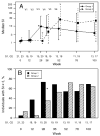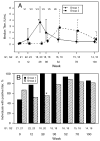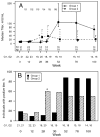Impaired immunity to recall antigens and neoantigens in severely immunocompromised children and adolescents during the first year of effective highly active antiretroviral therapy
- PMID: 18752430
- PMCID: PMC3895909
- DOI: 10.1086/592050
Impaired immunity to recall antigens and neoantigens in severely immunocompromised children and adolescents during the first year of effective highly active antiretroviral therapy
Abstract
Background: We studied whether severely immunocompromised, human immunodeficiency virus (HIV)-infected children who were beginning highly active antiretroviral therapy (HAART) or changing HAART regimens could spontaneously respond to a recall antigen (tetanus toxoid [TT] vaccine) or respond to a recall antigen and neoantigen (hepatitis A virus [HAV] vaccine) after 3 vaccinations.
Methods: A total of 46 children who had CD4 cell percentages <15% and who demonstrated a >0.75-log reduction in plasma HIV RNA levels within 4 weeks of starting HAART were randomized to receive vaccinations with either TT or HAV vaccines during the first 6 months of HAART. Study subjects then received the alternate vaccine during the next 6 months of HAART.
Results: Despite the early decline in viremia and the later increase in the percentage of CD4 T cells, spontaneous recovery of cell-mediated immunity (CMI) was not seen for TT. Serologic responses to TT required 3 vaccinations and were comparable in both groups. Serologic responses to HAV were infrequent and of low titer, although the group that received HAV vaccine after receiving TT vaccine performed somewhat better. CMI to HAV was virtually absent.
Conclusions: Severely immunocompromised children who are receiving HAART develop CMI and antibody to a recall antigen independent of the timing of vaccination, but they require a primary series of vaccinations. Antibodies to a neoantigen, HAV, developed when vaccination was delayed after initiation of HAART. CMI to a neoantigen was difficult to establish.
Trial registration: Clinicaltrials.gov identifier: NCT00004735/PACTG P1006 .
Conflict of interest statement
Potential conflicts of interest: none reported.
Figures




Similar articles
-
Virologic and immunologic correlates with the magnitude of antibody responses to the hepatitis A vaccine in HIV-infected children on highly active antiretroviral treatment.J Acquir Immune Defic Syndr. 2009 Sep 1;52(1):17-24. doi: 10.1097/QAI.0b013e3181b011f6. J Acquir Immune Defic Syndr. 2009. PMID: 19617848 Free PMC article. Clinical Trial.
-
Antibody responses to hepatitis A virus vaccine in HIV-infected children with evidence of immunologic reconstitution while receiving highly active antiretroviral therapy.J Infect Dis. 2006 Jan 15;193(2):302-11. doi: 10.1086/498979. Epub 2005 Dec 7. J Infect Dis. 2006. PMID: 16362896
-
Cellular and humoral immune responses to a tetanus toxoid booster in perinatally HIV-1-infected children and adolescents receiving highly active antiretroviral therapy (HAART).Eur J Pediatr. 2007 Jan;166(1):51-6. doi: 10.1007/s00431-006-0184-2. Epub 2006 Jul 26. Eur J Pediatr. 2007. PMID: 16868780
-
Inflammatory reactions in HIV-1-infected persons after initiation of highly active antiretroviral therapy.Ann Intern Med. 2000 Sep 19;133(6):447-54. doi: 10.7326/0003-4819-133-6-200009190-00013. Ann Intern Med. 2000. PMID: 10975963 Review.
-
Do children infected with HIV receiving HAART need to be revaccinated?Lancet Infect Dis. 2010 Sep;10(9):630-42. doi: 10.1016/S1473-3099(10)70116-X. Lancet Infect Dis. 2010. PMID: 20797645 Review.
Cited by
-
Virologic and immunologic correlates with the magnitude of antibody responses to the hepatitis A vaccine in HIV-infected children on highly active antiretroviral treatment.J Acquir Immune Defic Syndr. 2009 Sep 1;52(1):17-24. doi: 10.1097/QAI.0b013e3181b011f6. J Acquir Immune Defic Syndr. 2009. PMID: 19617848 Free PMC article. Clinical Trial.
-
Effect of HIV exposure and timing of antiretroviral therapy initiation on immune memory responses to diphtheria, tetanus, whole cell pertussis and hepatitis B vaccines.Expert Rev Vaccines. 2019 Jan;18(1):95-104. doi: 10.1080/14760584.2019.1547195. Epub 2018 Nov 19. Expert Rev Vaccines. 2019. PMID: 30417710 Free PMC article. Clinical Trial.
-
IL-10-producing B cells are induced early in HIV-1 infection and suppress HIV-1-specific T cell responses.PLoS One. 2014 Feb 21;9(2):e89236. doi: 10.1371/journal.pone.0089236. eCollection 2014. PLoS One. 2014. PMID: 24586620 Free PMC article.
-
SIV infection of rhesus macaques results in dysfunctional T- and B-cell responses to neo and recall Leishmania major vaccination.Blood. 2011 Nov 24;118(22):5803-12. doi: 10.1182/blood-2011-07-365874. Epub 2011 Sep 29. Blood. 2011. PMID: 21960586 Free PMC article.
-
[Persistence of hepatitis A virus antibodies after primary immunization and response to revaccination in children and adolescents with perinatal HIV exposure].Rev Paul Pediatr. 2015 Apr-Jun;33(2):142-9. doi: 10.1016/j.rpped.2014.09.005. Epub 2015 Mar 28. Rev Paul Pediatr. 2015. PMID: 25918013 Free PMC article.
References
-
- Gortmaker SL, Hughes M, Cervia J, et al. Effect of combination therapy including protease inhibitors on mortality among children and adolescents infected with HIV-1. N Engl J Med. 2001;345:1522–8. - PubMed
-
- Sanchez JM, Ramos Amador JT, Fernandez de Miguel S, et al. Impact of highly active antiretroviral therapy on the morbidity and mortality in Spanish human immunodeficiency virus-infected children. Pediatr Infect Dis J. 2003;22:863–7. - PubMed
-
- Gona P, Van Dyke RB, Williams PL, Dankner WM, Chernoff MC, Nachman SA, Seage GR., 3rd Incidence of opportunistic and other infections in HIV-infected children in the HAART era. JAMA. 2006;296:330–1. - PubMed
-
- Viani RM, Arenata MR, Deville JG, Spector SA. Decrease in hospitalization and mortality rates among children with perinatally acquired HIV type 1 infection receiving highly active antiretroviral therapy. Clin Infect Dis. 2004;39:725–31. - PubMed
-
- Resino S, Bellon JM, Resino R, et al. Extensive implementation of highly active antiretroviral therapy shows great effect on survival and surrogate markers in vertically HIV-infected children. Clin Infect Dis. 2004;38:1605–12. - PubMed
Publication types
MeSH terms
Substances
Associated data
Grants and funding
LinkOut - more resources
Full Text Sources
Medical
Research Materials

